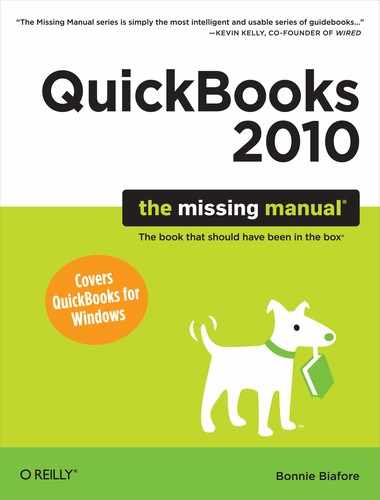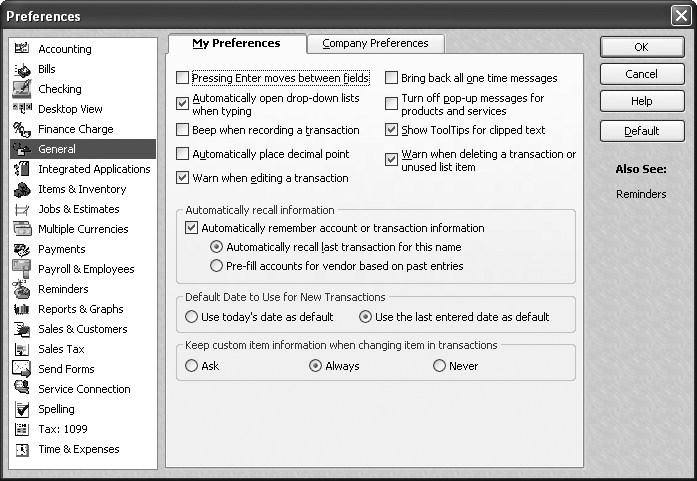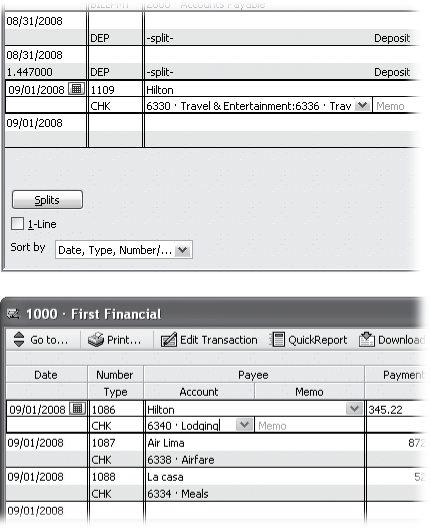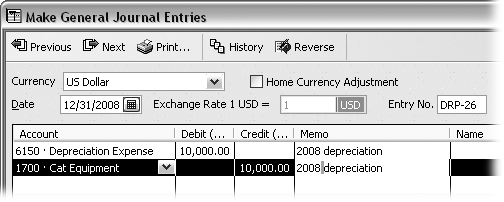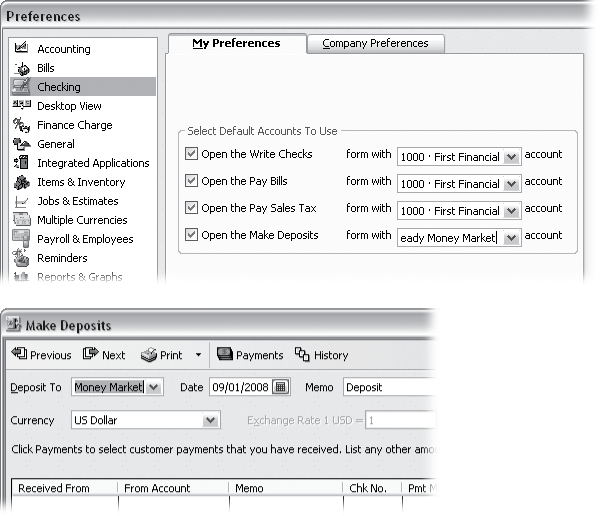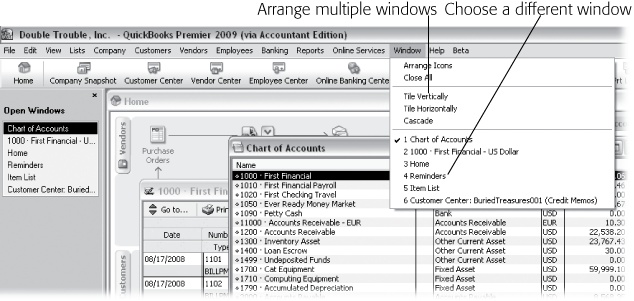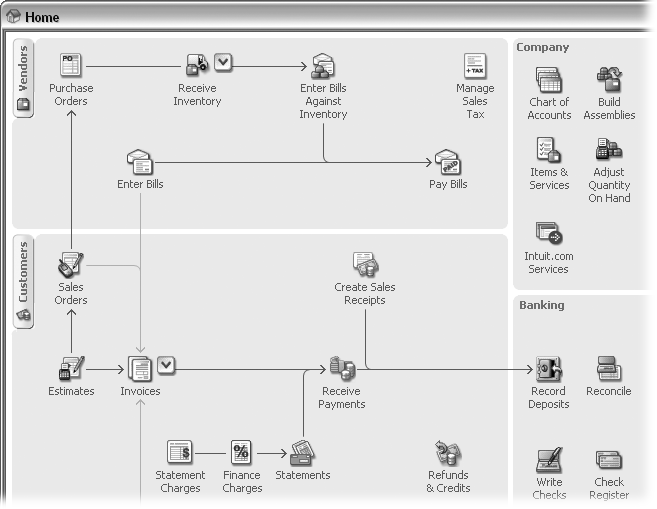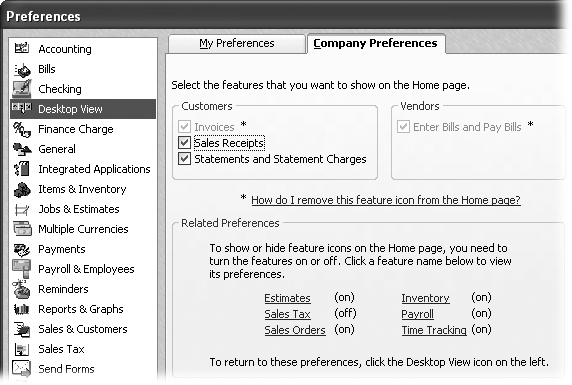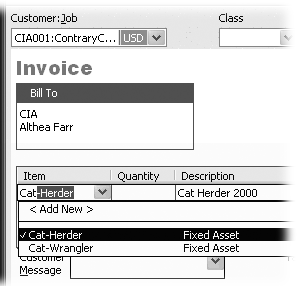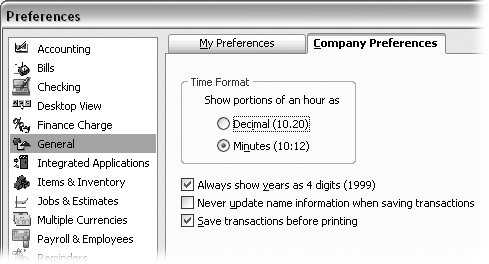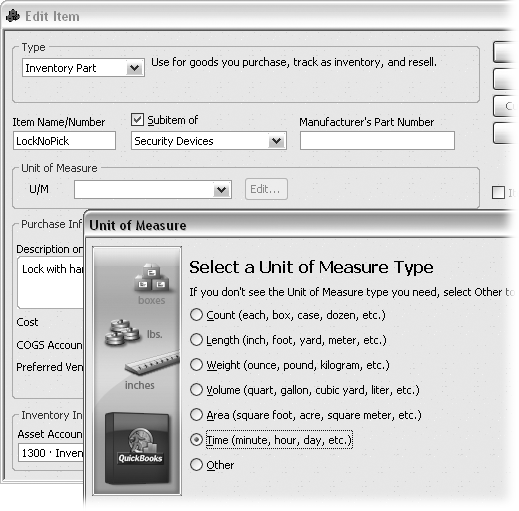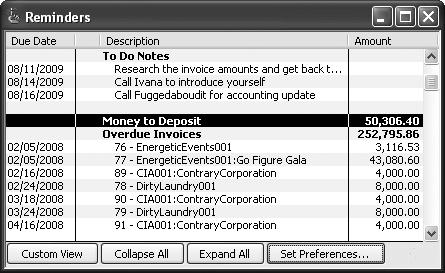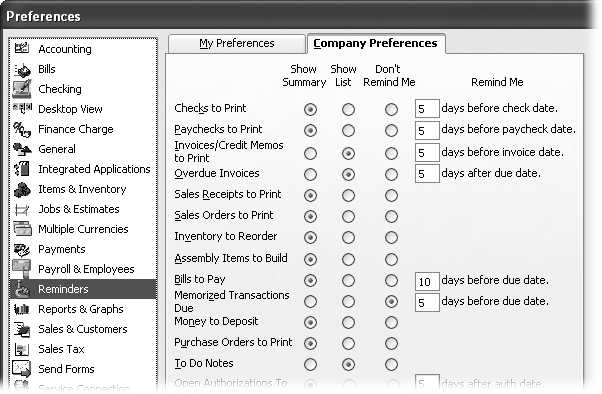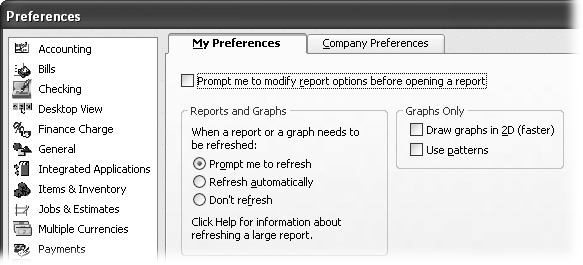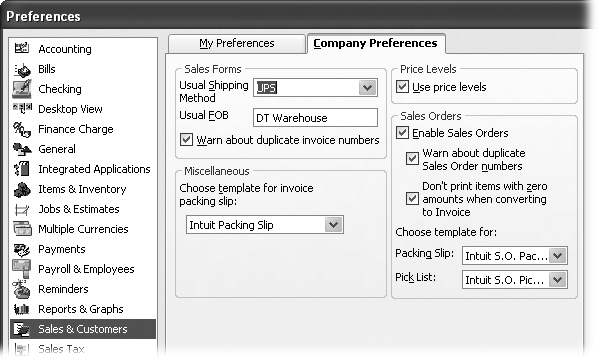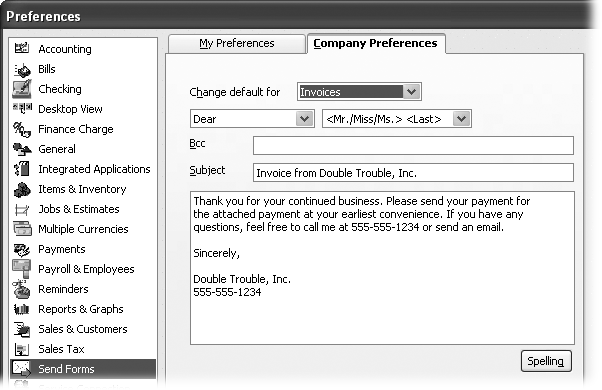Chapter 23. Configuring Preferences to Fit Your Company
An organization’s approach to accounting often depends on business objectives, policies, procedures, and the industry in which the organization operates. Maybe you want inventory tracking and payroll or maybe you don’t. The way you and your accountant like to work also influences your organization’s accounting practices. For instance, you might prefer the simplicity of cash accounting or the more intimate pairing of income and expenses that accrual accounting (Accounting Basics—The Important Stuff) offers.
Enter QuickBooks, an accounting program with the Herculean task of satisfying every nuance of business operation and personal proclivity. QuickBooks preferences are configurable settings that accommodate different business styles and personal tastes. During installation, QuickBooks picks the settings likely to work for a majority of organizations. And if you set up your QuickBooks file using the EasyStep Interview (Company Information), you might already have most preferences set the way you want.
But you can reset preferences to control all sorts of QuickBooks behaviors and features, such as whether you create estimates for jobs you go after or how you calculate the amount of inventory that’s available. Preferences also let you turn on QuickBooks features, such as inventory and payroll. Using QuickBooks for a while can make it clear which preferences you need to change. This chapter presents all the preferences that QuickBooks has and helps you determine which settings are appropriate for you and your organization.
Note
You can toggle most preferences at any time, but you can’t turn the preference for multiple currencies off once you turn it on. Before you change any preferences, back up your company file. Then, feel free to tweak and tinker with your preferences.
An Introduction to Preferences
You can’t quibble over quantity when QuickBooks gives you 21 categories of preferences that control QuickBooks’ behavior. Each preference category has several settings, so finding the preferences that do what you want is your biggest challenge. To view and set preferences, open the Preferences dialog box by choosing Edit → Preferences.
On the left side of the Preferences dialog box is a pane containing icons for each preference category, as shown in Figure 23-1. To display the preferences within a category, click the appropriate icon in the pane. QuickBooks highlights the icon you click to indicate that it’s active.
To accommodate both company and personal preferences, QuickBooks includes two tabs for each category:
My Preferences. As you might expect, the My Preferences tab contains options that people who log into QuickBooks can set for their QuickBooks sessions alone. For example, you can choose options in the Desktop View preference category if you want to look at multiple windows using a lurid purple color scheme (called Grappa Granite), without forcing your tastes on everyone else.
Company Preferences. Some preferences have to remain consistent for everyone in an organization. For example, the IRS won’t tolerate some financial reports produced using cash accounting and others using accrual accounting (see Accounting Basics—The Important Stuff for the pros and cons of each). The preferences that appear on the Company Preferences tab ensure consistency because they’re applied no matter who in your company logs in. To make sure company preferences are set properly, only folks who log in as QuickBooks administrators (see Setting Up the Administrator) can change the preferences on the Company Preferences tab.
Note
If you’re puzzled by QuickBooks’ habit of opening the Preferences dialog box to a My Preferences tab that has no preferences, rest assured that Intuit has its reasons. Only QuickBooks administrators can change settings on the Company Preferences tab. Rather than taunt the majority of people who log into QuickBooks with preferences they can’t modify, QuickBooks displays the My Preferences tab. But, for most preference categories, the Company Preferences tab is where the action is.
When you click OK to close the Preferences dialog box, QuickBooks saves the changes you made in the current preference category. What if you’re on an energetic mission to reset preferences in several categories? If you change preferences in one category and click the icon for another category, QuickBooks asks you whether you want to save the changes in the category you’re about to leave. Make sure you save what you want by clicking one of the following:
Yes. Click Yes to save the changes in the current category before switching to the category whose icon you clicked.
No. Click No to discard your changes and move on to the category whose icon you clicked.
Cancel. Click Cancel to discard your changes and remain in the current category so you can make other choices.
The rest of this chapter explains each set of preferences. They’re listed here in alphabetical order, as they are in the Preferences dialog box. You’ll also find preferences mentioned throughout this book where they apply to the bookkeeping tasks you perform.
Accounting
QuickBooks’ accounting preferences control key accounting practices, such as requiring accounts in transactions, assigning transactions to classes, and closing the books at the end of a fiscal year. Accounting practices stay the same throughout a company, so the Accounting Preferences reside on the Company Preferences tab. Here’s what they do:
Note
For QuickBooks Premier and Enterprise, the My Preferences tab has one preference: the “Autofill memo in general journal entry” checkbox. You keep the debit and credit sides of general journal entries linked by adding memos to the lines of the entries. Turn on this checkbox if you want QuickBooks to copy the memo you type for the first line of a journal entry to every subsequent line of the entry.
Use account numbers. In the accounting world, most people follow a numbering standard, which uses ranges of numbers for different types of accounts. For example, asset account numbers (bank accounts, inventory, and so on) run from 1000 to 1999; liability accounts (credit cards, loans, and so on) appear in the 2000 to 2999 range. If you work with an accountant, she’ll probably ask you to turn on this checkbox. By doing so, you can assign a number, in addition to a name, to each account you create.
Show lowest subaccount only. If you use only top-level accounts in your chart of accounts, you have no need for this behavior. But if your chart of accounts is a hierarchy of accounts and subaccounts as described on Creating an Account, turn on this checkbox to easily identify the subaccount you’ve selected in an Account field, as shown in Figure 23-2.
Figure 23-2. Top: In Account fields, QuickBooks links the name of the top-level account and the name of the subaccount, separating the two with a colon. For example, the top-level account 6330 Travel & Entertainment and the subaccount 6336 Lodging become “6330 Travel & Entertainment:6336 Lodging”. Because of the length of these combined names, only the top-level account is visible unless you scroll within the Account field. Bottom: When you turn on the “Show lowest subaccount only” checkbox, the Account field shows the subaccount number and name, which is exactly what you need to identify the assigned account.Require accounts. Details help you manage your business, but they’re essential to surviving the toughest of IRS audits. If detail isn’t your strong suit, turning on this checkbox forces you to assign an account to every item and transaction you create, which, in turn, creates a trail that you, your accountant, and the IRS can follow. For example, with the “Require accounts” checkbox turned on, when you click Record without an assigned account, QuickBooks warns you that you have to enter an account. To record the transaction, in the Warning message box, click OK. Then, choose the account in the transaction Account field. Now, when you click Record, QuickBooks completes the transaction without complaint.
If you turn this checkbox off and record transactions without assigned accounts, QuickBooks assigns the transaction amounts to either the Uncategorized Income or Uncategorized Expense accounts. For example, if you receive a payment from a customer and don’t assign an account to the deposit, that income posts to the Uncategorized Income account.
Use class tracking. When you want to track your business in more ways than accounts, customer types, and job types can offer, you can use classes (Filling in Expense Accounts Automatically) to add another level of categorization to your reports. For example, you can create classes to track the income that business units generate, regardless of which types of customers they support or the type of work they do. To activate the Class feature, turn on the “Use class tracking” checkbox, which adds a Class field in every transaction window.
Prompt to assign classes. If you turn on the Class feature, your reports by class won’t accurately reflect your business performance unless you assign classes to all your transactions. To make sure you assign classes consistently, turn on the “Prompt to assign classes” checkbox so that QuickBooks reminds you when you forget a class assignment for a transaction.
Automatically assign general journal entry number. Journal entries (Creating General Journal Entries) refer to the traditional approach to accounting, in which accountants assign credits and debits to accounts in paper-based journals. If you miscategorize a transaction, your accountant can create a journal entry to move dollars from your incorrectly assigned account to the correct account, for instance, moving company-paid health club dues from the Membership & Dues account you used to a more appropriate Employee Benefits account.
Discussing changes that you and your accountant make to your books is much easier when you can refer to journal entries by an identifier or number. There’s no reason to turn this checkbox off. With it on, QuickBooks makes sure that each general journal entry has a unique number. When you create a new general journal entry (see Creating General Journal Entries), QuickBooks increments the previous general journal entry number by one, as shown in Figure 23-3.
Note
If the previous entry number is blank, QuickBooks won’t automatically assign a number to the next entry. If you notice that QuickBooks has begun to shirk its automatic numbering duties, look for a blank entry number. Add numbers to any existing journal entries without them. Then, when you add a new journal entry, QuickBooks will number the next entry as it should.
Warn when posting a transaction to Retained Earnings. The program automatically turns on this checkbox, and it’s a good idea to leave it that way. QuickBooks creates the Retained Earnings account to track past profits that you’ve retained in the company’s coffers. For example, if your company earned $50,000 in 2010 and didn’t distribute that money to the owners or as profit-sharing bonuses to employees, that money becomes Retained Earnings once you begin 2011. QuickBooks updates the balance in the account automatically at the beginning of a new fiscal year by transferring the previous year’s net profit into it. This preference warns you before you post a transfer directly to the Retained Earning account and inadvertently create inaccurate records. (See Generating Tax Reports to learn how to differentiate your most recent year’s retained earnings from earlier retained earnings.)
Figure 23-3. QuickBooks follows your lead in numbering journal entries. For your first general journal entry, you can type a journal entry number, such as your initials and a sequence number (DRP-1, for example). As you create journal entries, QuickBooks increments the journal entry number to DRP-2, DRP-3, and so on.Date Warnings. If your books are up to date, then very old or very prescient dates are usually mistakes. To receive warnings for dates too far in the past or too far in the future, turn on the “Warn if transactions are _ day(s) in the past” checkbox and its companion, “Warn if transactions are _ day(s) in the future” checkbox. The boxes are set to 90 for past dates and 30 for future dates, but you can change them.
Closing date. After producing the financial reports for a fiscal year and paying corporate income taxes, most companies close their books, which means locking the transactions so no one can change anything. By closing the books, you ensure that your past transactions continue to match what you submitted to your accountant, reported to the IRS, and communicated to your shareholders.
When you use QuickBooks, your QuickBooks company file is synonymous with your “books.” Therefore, you close your books by clicking Set Date/Password and then choosing a date in the “Set Closing Date and Password” dialog box. For example, if you run your company on a calendar year and just reported and paid taxes for 2009, type or choose 12/31/2009.
If you absolutely have to edit a transaction that happened before the closing date, you can assign a password so that you can edit, delete, or create transactions that would alter account balances. In the “Set Closing Date and Password” dialog box, type the password in the Closing Date Password and Confirm Password boxes, and then click OK. If you have to edit a transaction prior to the closing date, you’ll first have to type the password.
Bills
The Bills category lets you specify how you want to handle the bills that vendors send you. The My Preferences tab is empty, so these settings all appear on the Company Preferences tab:
Bills are due _ days after receipt. The first time you access Bills preferences, you’ll find that QuickBooks has set this preference so that bills you enter show a due date 10 days after the date of the bill. For instance, if you receive a bill dated June 15, and in the Enter Bills dialog box fill in the Date field as such, QuickBooks automatically changes the Bill Due field to June 25. This value is fine in most cases. If a bill arrives that’s due in a different number of days, you can change its due date in the Enter Bill window’s Bill Due field.
Warn about duplicate bill numbers from same vendor. Surely you don’t want to pay the same bill twice, so be sure to turn on this checkbox so QuickBooks warns you that you’re entering a bill with the same number as one you already entered from the same vendor.
Paying Bills. If you want QuickBooks to automatically apply to your bills any credits and discounts to which you’re entitled, turn on the “Automatically use discounts and credits” checkbox. For example, if you typically receive a 15-percent discount on all purchases and also have a $100 credit, QuickBooks applies these adjustments to your bill before calculating the total. When you turn on this checkbox, in the Default Discount Account drop-down list, choose the account to which you usually post the discounts you take, for example, an expense account specifically for vendor discounts.
Note
Set up the payment terms that vendors extend to you in vendor records, as described on Job Type List.
Checking
Checking preferences let you set company-wide settings to control the appearance of the checks your company prints through QuickBooks. On the My Preferences tab in this category, you can also set preferences for the accounts that QuickBooks selects automatically for several types of financial transactions, as shown in Figure 23-4 (top).
Choosing the Bank Accounts You Use
If you have only one bank account, you can ignore the preferences for default accounts. QuickBooks automatically chooses your checking account for writing checks, paying bills, paying sales tax, and making deposits. But suppose your company has stores in several states and each store has its own checking account. Using the options on the My Preferences tab, each person who logs into QuickBooks can choose her store’s accounts for banking transactions. The person in Miami wants the Florida checking account to appear in the Write Checks window, but the person in New York wants to see the Manhattan checking account. To save some time (and prevent folks from selecting the wrong account in a drop-down list), set your accounts according to the following guidelines:
Open the Write Checks form with _ account. In the account drop-down list, choose the account you typically use to write checks. When you open the Write Checks window (Using the Write Checks Window), QuickBooks automatically fills in the Bank Account field with the account you specify here.
Open the Pay Bills form with _ account. In real life, paying bills and writing checks usually mean the same thing. In QuickBooks, you can enter bills you receive and pay them at a later date, as described on Selecting Bills to Pay. For this preference, choose the account you typically use to pay bills in the account drop-down list, which is often the same checking account that you chose in the “Open the Write Checks form with” preference. When you open the Pay Bills window, QuickBooks automatically fills in the A/P Account field (A/P stands for accounts payable) with the account you specify in this preference.
Open the Pay Sales Tax form with _ account. If you collect sales tax from your customers (see Inserting and deleting line items), you have to remit the taxes you collect to the appropriate tax authority, such as the state where your business is located. When it’s time to send the taxes in, you open the Pay Sales Tax dialog box and create a payment. This preference sets the account that QuickBooks uses in the Pay From Account field.
Open the Make Deposits form with _ account. Unlike the other options on the My Preferences tab, this preference sets up the account you typically use when you deposit money. For many small businesses, the deposit account and the checking account are one and the same. But some businesses deposit money into an account that pays interest, and then transfer money (see Transferring Funds) into a checking account only when it’s time to pay bills. After you choose the account you use to deposit money, the Make Deposits window (Recording Deposits) automatically fills in the Deposit To field with the account you specify here, as Figure 23-4 (bottom) shows.
Setting the Way Company Checks Work
Although a company might have several checking accounts, QuickBooks assumes that company checks should look the same no matter who prints them. Most preferences on the Company Preferences tab let you set the company standard for printing checks from QuickBooks. (If you use preprinted checks and write them out by hand, you can skip these options.)
Print account names on voucher. If the paper checks that you print include check stubs, you might as well turn on this checkbox. When you do, QuickBooks prints on the stub the account name for the account you used to pay the check. If you use only one bank account, printing the account name might not seem all that useful. But QuickBooks also prints the payroll item on the stub for payroll checks, and for checks used to purchase inventory, it prints the name of the inventory item you purchased—both of which can help you keep track of where your money is going.
Change check date when check is printed. When you turn on this checkbox, QuickBooks inserts the date that you print checks as the check date, which is just fine in most situations. You can enter checks into QuickBooks over several days, but date all the checks with the day you print them. Turn off this checkbox if you want to control the check dates, for example, to defer payments for a few days by post-dating checks for the day the payees receive them.
Start with payee field on check. Turning on this checkbox is a small but satisfying time-saver. If you always write checks from the same account, or you use the “Open the Write Checks form with” preference to specify an account (Choosing the Bank Accounts You Use), tabbing in the Write Checks window to skip the Bank Account field for each check transaction gets old quickly. When you turn on this checkbox, you can save one pesky keystroke each time you write a check.
Turning on this preference also opens the Enter Credit Card Charges window with the cursor in the Purchased From box.
Warn about duplicate check numbers. Not surprisingly, turning on this checkbox means that QuickBooks warns you that you’re trying to record a check with the same number as one you already entered.
Autofill payee account number in check memo. Just as you assign account numbers to your customers, the vendors you do business with assign your company an account number, too. Printing account numbers on the checks you write helps a vendor credit your account, even if the check gets separated from its accompanying payment slip. If you enter your company’s account number in each Vendor record in QuickBooks (Entering Address Information), turn this checkbox on to print these account numbers on your checks.
Choosing Company-Wide Payroll Accounts
The two Checking preferences in the Select Default Accounts To Use section of the Company Preferences tab let you set the accounts you use for payroll. QuickBooks might seem to jump the gun by offering company-wide settings for the accounts used for payroll and payroll liabilities, but most companies centralize payroll no matter how regional other operations are. If you don’t use QuickBooks payroll features, don’t bother with these preferences because you’ll never open the Create Paychecks or Pay Payroll Liabilities forms. (To learn how to turn on QuickBooks payroll features, refer to Payroll & Employees.)
Tip
A separate bank account for payroll simplifies reconciling your regular checking account, particularly for companies with numerous employees and weekly paychecks. Otherwise, you’ll have to reconcile dozens or even hundreds of paychecks each month in addition to the other checks you write.
Open the Create Paychecks form with _ account. In the account drop-down list, choose the account you use to write payroll checks. When you open the Create Paychecks window (Printing Paychecks and Pay Stubs), QuickBooks automatically fills in the Bank Account field with the account you specify in this preference.
Open the Pay Payroll Liabilities form with _ account. From the Account drop-down list, choose the account you use to pay payroll taxes.
Choosing the Online Banking Mode
In QuickBooks 2010, you can switch between the Online Banking Center from QuickBooks 2008 and earlier and the QuickBooks 2009 version of the center. The look might be different, but the online tasks you can perform are basically the same. And you can switch between the two modes any time you want by selecting the Side-by-side mode or Register mode options. See QuickBooks Online Banking Modes to learn how the two modes work.
Desktop View
Each person can customize the QuickBooks desktop for herself. You can fulfill your every desktop desire with the preferences on the My Preferences tab—your choices don’t affect anybody else who logs into QuickBooks. On the other hand, the Company Preferences tab includes preferences that control what appears on the QuickBooks Home page (Getting Around the QuickBooks Home Page).
Window Preferences
You can keep your desktop neat with only one window at a time, or you can view multiple windows:
One Window. If you’re not good at multitasking or you simply prefer full-size windows, choose the One Window option so that QuickBooks displays only one full-size window at a time. Although you can open multiple windows, they’re stacked on top of each other so you see only the top one. With this approach, you can switch windows by choosing windows in the Open Window List (choose View → Open Window List) or on the menu bar, choose Window and then choose the name of the window you want to display.
Multiple Windows. If you like to view several windows at a time or want to size windows based on how much information they display, as shown in Figure 23-5, choose the Multiple Windows option. When you choose this option, the Windows menu has commands such as Cascade and Tile Vertically for arranging windows.
Preferences for Saving the Desktop
On the My Preferences tab, the Desktop category gives you four choices for what QuickBooks does with the windows that are open when you exit the program. For example, if you have your windows arranged just the way you like, you can save your QuickBooks desktop so the windows open in exactly the same arrangement the next time you log in. Here’s the lowdown on why you might choose each option:
Save when closing company. If you typically continue bookkeeping tasks from one QuickBooks session to the next, this option saves the open windows and their positions when you exit QuickBooks. The next time you log in, QuickBooks opens the same windows and positions them where they were so you can finish entering the remaining 300 checks you have to write.
Choosing this option adds a small delay to the time it takes QuickBooks to close. If you’d rather have QuickBooks live up to its name and close more quickly, choose one of the other desktop options.
Save current desktop. If you have a favorite arrangement of windows that works well for the bulk of your efforts in QuickBooks, you can save that arrangement and display it every time you log in. To do this, first open the windows you want and position them. Open the Preferences dialog box, choose this option, and then click OK. When you choose this option, QuickBooks adds the “Keep previously saved desktop” option to the My Preferences tab.
Don’t save the desktop. Choosing this option displays a desktop with only the menu bar, the icon bar, the Home page, and the Reminders window. QuickBooks opens faster, and the Home page gives you fast access to the windows and dialog boxes you use regularly.
Keep previously saved desktop. Once you’ve saved a desktop you like, this option appears on the Desktop View My Preferences tab. Choose this option so that QuickBooks opens with the desktop as it was when you selected “Save current desktop”.
Show Home page when opening a company file. The Home page (Getting Around the QuickBooks Home Page) shows the entire workflow of your accounting tasks, as well as links to oft-opened windows like the Chart of Accounts window. Keep this checkbox turned on to see the Home page each time you log in.
Show Coach window and features. The Coach can help you learn your way around the program (The QuickBooks Coach). After you know what you’re doing, turn off this checkbox to work without handholding.
Show Live Community. Initially, this checkbox is turned on, which displays the Live Community window (Live Community) on the right side of the QuickBooks main window. If you want the Live Community and the help it offers to stay out of sight until you open it (choose Help → Live Community), turn off this checkbox.
Detach the Help Window. At long last, QuickBooks 2010 lets you position the Help window wherever you want, resize it to your heart’s content, and minimize it—all without affecting the main QuickBooks window. QuickBooks doesn’t turn this checkbox on out of the box, but you’ll want to. Otherwise, when you open the Help window, it sticks to the right side of the main QuickBooks window, where it reduces your QuickBooks window space and behaves in other annoying ways. See QuickBooks Help to learn more about QuickBooks Help.
Choosing a Color Scheme
The last preference of note on the My Preferences tab is Color Scheme. The standard color scheme that QuickBooks applies is neutral and easy on the eyes. If you’re color blind or simply like some color to brighten an otherwise dull financial day, choose one of the other built-in color schemes.
Setting Up the QuickBooks Home Page
Since QuickBooks automatically displays its Home page when launched, you probably know that this window lets you access almost any accounting task. As you can see in Figure 23-6, the Home page has three horizontal panels for tasks related to vendors, customers, and employees. The Desktop View Company Preferences tab is where you can customize what you see here.
On the Desktop View Company Preferences tab, simply turn on checkboxes to display the Home page icons for various tasks like sales receipts, statements, and paying bills, as shown in Figure 23-7. These checkboxes control only whether the icons appear in the workflow on the Home page. To set preferences for features like inventory, click their links in the Related Preferences section to switch to the appropriate preference category.
Finance Charge
If you’re lucky enough to have customers who always pay on time or if you run a nonprofit organization that graciously accepts donations, you can bypass this category of preferences. But if you want to add an incentive for customers to pay on time, finance charge preferences determine your level of leniency.
Because you probably don’t want each of your employees deciding how to charge customers for late payments, all the preferences in the Finance Charge category appear on the Company Preferences tab. Only someone logged into QuickBooks as an administrator can change these settings. To learn how to add the finance charges configured here to the invoices you create, see Applying Finance Charges.
Tip
If you plan to charge late fees, include the finance charge terms in your contracts. Your customers are less likely to complain if the added charges aren’t a surprise.
Here are the finance charge preferences you can set and what they mean to your customers:
Annual Interest Rate (%). Type the interest rate that you charge per year for overdue payments. For example, if you charge 18 percent per year, type 18 in the Annual Interest Rate (%) box. QuickBooks calculates the finance charge due by prorating the annual interest date to the number of days that the payment is late.
Minimum Finance Charge. If you charge a minimum finance charge no matter how inconsequential the overdue amount, type that minimum value in this box. For example, to charge at least 20 dollars, type 20. If you work with more than one currency, you still specify your minimum finance charge in your home currency. QuickBooks converts the finance charge to the customer’s currency when you apply finance charges.
Grace Period (days). Just like the grace period that you probably enjoy on your mortgage, the grace period in QuickBooks is the number of days that a payment can be late before finance charges kick in. In the “Grace Period (days)” box, type the number of days of grace you’re willing to extend to your customers.
Finance Charge Account. Choose the account you use to track finance charges you collect. Most companies create an Other Income account (Creating an Account) to track finance charges, which are interest income.
Assess finance charges on overdue finance charges. If a customer goes AWOL and doesn’t pay the bill or the finance charges, you can get tough and levy finance charges on the finance charges that the customer already owes. If your customer owes $100 in finance charges and you assess an 18% finance charge, turning on this checkbox would result in an additional $18 a year on the outstanding finance charges alone.
Calculate charges from. You can calculate finance charges from two different dates, depending on how painful you want the finance charge penalty to be. Choosing the “due date” option is the more lenient approach. For this option, QuickBooks assesses finance charges only on the days that an invoice is paid past its due date. For example, if the customer pays 10 days after the due date, QuickBooks calculates the finance charges for 10 days. If you want to assess finance charges from the date on an invoice, choose the “invoice/billed date” option. If the customer pays 10 days late on a Net 30 invoice (meaning payment is due no more than 30 days after the invoice date), QuickBooks calculates finance charges based on 40 days—the 30 days until the invoice was due and the 10 days that the payment was late.
Mark finance charge invoices “To be printed”. If you want QuickBooks to remind you to print invoices with finance charges, turn on this checkbox. Invoices that you haven’t printed yet appear as alerts in the Reminders window.
General
You might find it odd that the most common preferences appear in the middle of the preferences list. And it’s even stranger that QuickBooks selects the General preferences category the very first time you open the Preferences dialog box. What gives? Simple—the preference categories appear in alphabetical order.
Don’t bypass the General settings. They can make your QuickBooks sessions either a breeze or an annoyance. Most of the General preferences appear on the My Preferences tab, but a few apply to everyone who logs into QuickBooks.
Tuning QuickBooks to Your Liking
The following settings on the My Preferences tab can help you fine-tune QuickBooks’ behavior:
Pressing Enter moves between fields. In the Windows world, pressing the Enter key usually activates the default button in a dialog box, while the Tab key advances the cursor to the next field. If you press Enter in QuickBooks and find that your dialog box closes unexpectedly, this QuickBooks checkbox can provide some relief. When you turn on this checkbox, pressing Enter moves the cursor between fields in a dialog box rather than closing it. However, because Enter no longer closes a dialog box, you have to click a button to do so, such as OK, Record, Save & Close, or Save & New (depending on the dialog box). You can also press Ctrl+Enter to close a dialog box.
Automatically open drop-down lists when typing. This preference makes drop-down menus spring open as soon as you type a letter in a field, as shown in Figure 23-8. You can then click the entry you want.
Beep when recording a transaction. If you like auditory assurance that your software is working, turn on this checkbox to have QuickBooks beep when it records a transaction. If you grow tired of QuickBooks sounding like an arcade game, simply return to the Preferences dialog box and turn off this checkbox. (Remember, you’ll hear beeps only if you haven’t muted the audio on your computer.)
Automatically place decimal point. When you turn on this checkbox, QuickBooks automatically places a decimal so that the last two numbers you type represent cents. For example, typing 19995 automatically becomes 199.95. (If you want to enter a whole dollar, type the decimal point at the end of the number.) Having QuickBooks place decimal points in numbers for you can be quite addictive once you get used to it, particularly if you haven’t graduated to rapid-fire numeric entry on the numeric keypad of your computer—or, if you work on a laptop and haven’t realized that your keyboard has a numeric keypad.
Figure 23-8. The drop-down list appears as soon as you begin typing an entry in a field, so you can keep typing or click an entry. The list narrows down to the choices that match the letters you’ve typed so far (like showing Cat-Herder and Cat-Wrangler for the letters “cat”). You can also expand or contract the width of the drop-down list by dragging the bottom-right corner to show as much or as little information as you want.Warn when editing a transaction. QuickBooks turns on this checkbox automatically, which means that the program displays a warning if you edit a transaction and attempt to leave it (for instance, by clicking another transaction) without explicitly recording the change. If you inadvertently modify a check or invoice, this warning gives you a chance to exit without saving the changes.
If you decide to turn off this feature, QuickBooks automatically records transactions that aren’t linked to other transactions. However, if a transaction has links—such as a payment that links to a customer invoice—you need to record transactions after you change them regardless of how you’ve set this preference.
Bring back all one-time messages. One-time messages instruct beginners in the ways of QuickBooks, but for experienced fans, these messages are merely annoyances. The only time you might want to turn on this checkbox is if you were overly enthusiastic about hiding one-time messages and find yourself in need of QuickBooks’ mentoring once more.
Turn off pop-up messages for products and services. Out of the box, QuickBooks displays its own pop-up messages about other products and services Intuit would love to sell to you. Turn this checkbox off to stop the marketing.
Show ToolTips for clipped text. Text in QuickBooks fields is often longer than what you can see on the screen. For example, if you see the text “Make sure you always” in a text box, you’ll want to see the rest of the message. This checkbox, which QuickBooks turns on automatically, tells QuickBooks to display the entire contents of a field when you position the mouse over it.
Warn when deleting a transaction or unused list item. QuickBooks turns this checkbox on automatically, so you have to confirm that you want to delete a transaction, such as a deposit or check, or a list item that’s never been used in a transaction. Caution is a watchword in the financial world. Although QuickBooks lets you delete transactions, it’s a good idea to include this extra step to make sure you’re deleting what you want. If you turn off this checkbox, you can delete a transaction without confirmation.
Note
Regardless of how this preference is set, QuickBooks won’t let you delete a list item, such as a customer type or shipping method you use, if it’s been used even once in a transaction. Learn what you’ve got to do to delete or inactivate list items on Hiding and Deleting Items.
Automatically remember account or transaction information. Do you write similar checks or incur similar credit charges each month? Say you write checks each month from the same account for your Internet access. Those transactions include the same vendor, the same amount, and post to the same account. QuickBooks turns on the “Automatically remember account or transaction information” checkbox and selects the “Automatically recall last transaction for this name” option to make these recurring transactions easy. When you type a name in a transaction, QuickBooks fills in the rest of the fields in the transaction with the values you used in the last transaction for that name. If you select the “Pre-fill accounts for vendor based on past entries” option, QuickBooks automatically fills in the accounts you use consistently for vendor transactions. Since you can set up pre-fill accounts for vendors with other QuickBooks features (Filling in Expense Accounts Automatically), the “Automatically recall last transaction for this name” option gives more bang for the buck.
AutoRecall has a couple of limitations you should keep in mind. You can’t recall a transaction in one account if the previous transaction was in another account. In addition, you can recall transactions for bills, checks, and credit card charges only. For other transactions—such as purchase orders, invoices, sales receipts, and credit memos—you have to fill in all the fields or use a memorized transaction.
Tip
It’s a rare occurrence, but if you find this automated data entry more of a hindrance than help, turn off the “Automatically remember account or transaction information” checkbox. You can still reuse transactions by memorizing them and choosing them from the Memorized Transaction List, described on Using a Memorized Transaction.
Default date to use for new transactions. In this section of the My Preferences tab, choose the “Use today’s date as default” option if you want QuickBooks to fill in the date field with the current date for every new transaction you create.
If you create invoices over the course of several days but you want each invoice to reflect the first day of the month, choose the “Use the last entered date as default” option. In the first invoice you create, type the date you want for all your invoices. For subsequent invoices, QuickBooks fills in the Date field with the date you entered on the previous invoice. When you want to use a new date (after all the invoices are complete), simply type the new date in your next transaction.
Keep custom item information when changing item in transactions. This setting determines how QuickBooks responds when you change an item in a transaction after customizing its description. Say you add an item to an invoice, edit the description in the invoice, and then realize that you added the wrong item. When you choose a new item to replace it, if you’ve selected the Ask option in Preferences, QuickBooks asks you if you want to use the edited description for the new item. The Always option automatically applies the edited description to the new item. With the Never option, QuickBooks replaces the item immediately, using the description from the new item’s record.
Company-Wide General Preferences
The Company Preferences tab includes four preferences, shown in Figure 23-9. Only a QuickBooks administrator can change these settings. Here’s what these preferences do:
Show portions of an hour as. You can enter hours in one of two ways—as decimal numbers that represent hours and fractions of an hour, or as hours and minutes separated by a colon, as you can see in Figure 23-9. This preference tells QuickBooks which way to display time values.
Always show years as 4 digits. Turning on this feature tells QuickBooks to display all four digits of the year whether you type two digits or four. For example, if you type 09, then QuickBooks displays 2009. Turning off this checkbox shows years as two digits.
When you type a two-digit number for a year, QuickBooks translates numbers from 00 through 38 as years 2000 through 2038. Numbers 39 through 99 become 1939 through 1999.
Figure 23-9. To display hours and minutes as a decimal number, choose the Decimal option. For example, if you type 15:45 (15 hours and 45 minutes) in a time field, QuickBooks converts the value to 15.75. To display hours and minutes, choose the Minutes option. For this option, QuickBooks displays the entry 5.4 as 5:24.Tip
When you turn off the “Always show years as 4 digits” checkbox, QuickBooks does as it’s told and displays only two digits for the year. If a date field shows 40 and you want to see whether that stands for 1940 or 2040, in the date field, click the Calendar icon. The Calendar shows both the month and the full four-digit year.
Never update name information when saving transactions. QuickBooks comes set so that when you change information for a name, such as a customer or vendor, the program asks if you want to replicate that change back in the original record—on the Customer:Job List or Vendor List. Possibly the only time you might want to change this behavior (which you do by turning on this checkbox) is if you use generic names, such as Donor or Member. If you receive donations and your donors want receipts with their names and addresses filled in, you don’t want the names and addresses you enter on sales receipts to alter your generic donor record.
Save transactions before printing. QuickBooks turns this checkbox on initially, and it’s a good idea to leave it that way. It tells QuickBooks to save a transaction before you print it, so the transaction in QuickBooks is the same as the one you print. If you turn this checkbox off, you could print the transaction with one set of data and then close the dialog box without saving that data, thus making your QuickBooks books different from your paper records.
Integrated Applications
As you’ll learn in more detail in Chapter 24, QuickBooks plays well with other programs, like Microsoft Excel and Access. For example, by integrating Microsoft Outlook with QuickBooks, you can easily keep your contact information synchronized in both programs. Third-party vendors create all sorts of programs that integrate with QuickBooks for tasks like document management, project tracking, creating bar codes, and so on. If you’re a QuickBooks administrator, the Integrated Applications preferences category is where you control which programs can interact with QuickBooks and the extent of their interaction. For example, you can use another program to produce estimates and want to transfer the completed estimates into QuickBooks to fill out invoices and other forms.
Sometimes third-party programs alter key QuickBooks features, such as your chart of accounts and invoice items. So before you try to integrate a new program, back up your QuickBooks file. After you integrate a program, check your QuickBooks file for unwanted changes, such as new accounts or classes that you don’t want. Depending on what you find, you can restore your backup, modify your lists manually, or leave things the way they are.
To access these preferences, choose Edit → Preferences and click the Integrated Applications icon. Here’s a guide to setting the preferences on the Company Preferences tab to allow or restrict other programs’ access to your QuickBooks file:
Don’t allow any applications to access this company file. The quickest way to lock down a QuickBooks file against access by other programs is to turn on this checkbox. When you do so, QuickBooks prevents integrated programs from accessing the file and also suppresses the display of screens that allow people to authorize access. If you want QuickBooks to display access screens, turn on this checkbox. Others can authorize access only if a QuickBooks administrator sets up their accounts to do so, as discussed on Restricting Access to Features and Data.
Notify the user before running any application whose certificate has expired. The most security conscious of administrators might turn on this checkbox to see a warning if a program trying to access the QuickBooks file has an expired certificate. But an expired certificate doesn’t mean that the program has changed or has morphed into malicious code—it indicates only that the certificate has expired. For most administrators, turning off this checkbox is preferable.
Applications that have previously requested access to this company file. When programs request access to a QuickBooks file, QuickBooks displays an access screen to the QuickBooks administrator who has to approve or deny access. Programs that have received approval to access your company file appear in this list. To deny access to one of these programs, click the checkmark in the Allow Access column, or select the program, and then click Remove.
Items & Inventory
The Items & Inventory preferences apply mainly to what QuickBooks does when you create purchase orders or invoices for inventory. The first checkbox is the most important: Turning on the “Inventory and purchase orders are active” checkbox tells QuickBooks that you want to track inventory, which activates the program’s inventory-related features (The QuickBooks Inventory Process). If you turn inventory tracking on, here are the settings you may want to adjust as well:
Inventory and purchase orders are active. If you want to track inventory using QuickBooks, turn on this checkbox. After doing so, you can perform inventory related tasks like creating inventory part items, producing purchase orders, and generating inventory reports. Turning this checkbox on adds icons like Purchase Orders and Receive Inventory to the Home page.
Warn about duplicate purchase order numbers. Turn on this checkbox if you want QuickBooks to warn you when you’re creating a purchase order with the same number as one you already entered.
Calculating the quantity available. QuickBooks actually tracks two quantities for inventory items. Quantity On Hand is always the actual number of items sitting in inventory. Quantity Available can equal Quantity On Hand, but you can also tell QuickBooks to calculate the quantity available by deducting the number of items already on sales orders or used in pending builds (when you build products out of components). If you use sales orders (Using Pending Invoices for Backorders) to track orders that haven’t been invoiced, QuickBooks automatically turns on the “Quantity on Sales Order” checkbox. With this setting, QuickBooks calculates how many items in inventory are available by deducting the number of items on sales orders from the number of items on hand, which helps prevent out-of-stock items. If you turn this checkbox off, the quantity available reflects the inventory that’s been invoiced and shipped, so you won’t know that your inventory is low until you start filling the sales orders you created.
Warn if not enough inventory to sell. If you prepare an invoice to sell more doodads than you have in stock, QuickBooks warns you—if this checkbox is turned on. Suppose you sell 500 quarts of sesame soy swirl frozen yogurt, but you have only 400 quarts in stock. When you attempt to save the invoice for the 500-quart order, QuickBooks displays a warning message box informing you of your shortage. But QuickBooks doesn’t go any further than that. You can save the invoice, but it’s up to you to order more inventory.
Besides giving you a heads-up that inventory is low, this setting helps you keep your customers happy, since you can ask them if they want to wait for a back-order to be filled. Select the appropriate option to tell QuickBooks whether you want a warning based on the Quantity On Hand or the Quantity Available. Because Quantity Available can be lower than the Quantity On Hand, that’s the safest route.
Note
In some QuickBooks Premier Editions (Accountant, Contractor, and Manufacturing & Wholesale) and QuickBooks Enterprise, you can specify different units of measure for inventory items, in case you sell wine by the bottle, by the case, and by the vat, for example. In the “Unit of Measure” section, click Enable. Then, select the Multiple U/M Per Item option. With this option selected, the Create Item and Edit Item windows include a unit of measure field, as shown in Figure 23-10.
Jobs & Estimates
If you create estimates or document job progress in QuickBooks, head to the Jobs & Estimates preferences category to set up your progress terminology and estimating features. Although QuickBooks forces nonprofits to think in terms of customers, it does let you choose the terminology you prefer for progress on a job. For example, if you’re a professional gigolo, your terminology for a woman you didn’t win over might be “TooSmart,” and you can instruct QuickBooks to display that term in the Job Status field.
QuickBooks includes five fields for job status: Pending, Awarded, “In progress”, Closed, and “Not awarded”. Despite QuickBooks’ field names, you can type any term you want for status in any of the five boxes. You can type Waiting in the Pending box, Whoopie! in the Awarded box, and Finally! in the Closed box. Then, when you edit a job and display the Job Status drop-down list, you can choose from these terms.
The rest of the preferences on the Company Preferences tab relate to estimates and progress invoicing. Choose any or all of the following preferences:
Do You Create Estimates? This question is simple but, unfortunately, misleading. If you create estimates in a program other than QuickBooks, you still choose the No option. Only choose the Yes option if you want to create estimates in QuickBooks, as described on Creating an Estimate. Selecting Yes adds an Estimates icon to the Home page.
Do You Do Progress Invoicing? Also known as “partial billing,” progress invoicing means that you invoice your customer for work as you go instead of billing for the entire job at the end. For example, if you’re building a shopping mall, you don’t want to carry the costs of construction until shoppers walk in the front door. You want to charge your client as you meet milestones. To create invoices for portions of your estimates, choose the Yes option. Then, you can invoice for part of an estimate and show how much you billed previously, as described in more detail on Creating Progress Invoices.
If you choose the No option, you can create progress invoices from your entire estimate. After you bring the entire estimate into your invoice, remove entries until the invoice includes only what you want to bill. The flaw in this approach is that you can’t show previous totals billed or compare the amount billed and remaining to your estimate.
Warn about duplicate estimate numbers. Turn on this checkbox if you want QuickBooks to warn you if you’re creating an estimate with the same number as one you already entered.
Don’t print items that have zero amount. When you produce progress invoices, you might not charge for every estimated item on every progress invoice. To keep your progress invoices tidy, suppress the items that you’re not charging for by turning on this checkbox.
Multiple Currencies
If you use only one currency, you can skip this preference section, because QuickBooks automatically selects the “No, I use only one currency” option, as shown in Figure 23-11. But if you have customers who pay you in other currencies, or vendors who want to be paid in their country’s currencies, you can turn on the multiple currency preference. Once you do, it’s on for good. However, if you stop doing business with foreign-currency customers and vendors, you can simply skip the currency boxes in QuickBooks’ windows and dialog boxes. (QuickBooks automatically fills them in with your home currency.)
To turn on multiple currencies, in the Preferences dialog box, click the Multiple Currencies icon, and then click the Company Preferences tab. Select the “Yes, I use more than one currency” option. In the “Select the home currency you use in transactions” drop-down list, choose the currency you use.
Payments
QuickBooks 2010 includes one new category of preferences: Payments. The preferences for applying and calculating payments have relocated from the Sales & Customers category. However, this category also includes links you can click if you want to sign up for Intuit’s credit card, paper check, or eCheck processing services.
Intuit Payment Solutions. Intuit offers QuickBooks Merchant Services for processing payments from your customers, whether you want to accept credit card payments or process checks electronically. To sign up for one or more of these services, click the Get Started link for the service to open a browser window to the sign-up page.
Automatically apply payments. This checkbox in the Receive Payment section is best left turned off, which means you have to manually match payments you receive to the corresponding customer invoices. When you turn this checkbox on, QuickBooks applies customer payments to invoices for you. If a payment doesn’t match any of the invoice amounts, QuickBooks applies the payment to the oldest invoices first, which could mask the fact that a payment wasn’t received or that a customer’s check was for the wrong amount.
Automatically calculate payments. This preference is also better kept turned off. When you receive a payment from a customer, in the Receive Payments window’s Amount box, you typically type the amount that the customer sent. Then, as you choose the invoices to apply the payment to, you can see if the payment balances the amount the customer owes. If the customer underpaid, QuickBooks asks you if you want to keep the underpayment or write off the amount that the customer did not pay. If you turn on this checkbox, QuickBooks calculates the payment for you as you choose invoices, so discrepancies aren’t readily apparent.
Use Undeposited Funds as a default deposit to account. If you typically collect a few payments before heading to the bank to deposit them, turn on this checkbox so QuickBooks automatically adds payments you receive to the Undeposited Funds account. When you turn on this checkbox, QuickBooks doesn’t show the “Deposit to” box in the Receive Payments window, so you have no choice but to deposit payments to Undeposited Funds. If you want a choice about whether to deposit payments right away, keep this checkbox turned off. Then, in the Receive Payments window’s Deposit To field, you can choose a bank account to deposit funds immediately, or you can choose Undeposited Funds to collect several payments before you make a deposit.
Payroll & Employees
Perhaps the most annoying things about employees is their insistence on being paid. Sad to say, but using QuickBooks for payroll doesn’t eliminate the need to transfer money from your company into your employees’ pockets, but it can simplify the task. If you choose one of the QuickBooks payroll service options, the Payroll & Employees preference category is command central for configuring your payroll service and how it operates. Payroll and employee preferences appear on the Company Preferences tab, so only QuickBooks administrators can set them.
Tip
If you’d rather someone else incur brain damage figuring out government payroll requirements, on the QuickBooks menu bar, choose Employees → Payroll → Learn About Payroll Options. In a Web browser window, the Intuit QuickBooks Payroll screen displays buttons to learn more. If you like what you see, you can then sign up for one of Intuit’s payroll services.
On the Company Preferences tab, the QuickBooks Payroll Features area gives you three options for choosing a payroll service: Full Payroll, No Payroll, and Complete Payroll Customers. Because the option labels don’t tell the entire story, this list helps you determine which one you should choose:
Full Payroll. If you want to produce payroll documents such as paychecks; payroll reports; and payroll forms, including 940 (employer federal unemployment tax), 941 (employer quarterly federal taxes), W-2 (employee wage and tax statement), and W-3 (transmittal of W-2s), choose this option. Full Payroll is the option you want if you plan to calculate payroll yourself and use QuickBooks’ features to produce the documents—or, if you use QuickBooks Basic Payroll, Standard Payroll, Enhanced Payroll, or Assisted Payroll to figure out payroll amounts.
Tip
If you want to allocate wages and payroll taxes to jobs, you have two choices. If you use a third-party payroll service, you can select the No Payroll option and then use journal entries to reassign payroll and payroll taxes to jobs. The other alternative is to choose the Full Payroll option and use QuickBooks’ payroll features to assign payroll and payroll taxes to jobs. See Applying for a Payroll Service for details.
No Payroll. Only two situations warrant choosing the No Payroll option: you don’t run payroll in any way, or you use a third-party payroll service and don’t want to assign payroll amounts to job costs. If you’re a sole proprietor and pay yourself by taking owner’s draws, this is the right option. Likewise, if you use an outside payroll service, such as Paychex or ADP, and have no need to print payroll documents or assign payroll costs to jobs, choose this option. With this option selected, QuickBooks suppresses the appearance of payroll-related commands on the Employees menu and in the Employee Center.
Complete Payroll Customers. If you use Intuit Complete Payroll, a full-blown outsourced payroll service described on Applying for a Payroll Service, choose this option. When you use Intuit Complete Payroll, you transmit your payroll data from QuickBooks to the payroll service, and then import the processed payroll transactions from the service into QuickBooks.
The Payroll & Employees preference category has plenty of additional settings, which are intimately linked to payroll and described in detail in Chapter 14. For example, you can specify the deductions and payroll items that affect every employee, and you can control the fields that appear on paychecks and paycheck stubs.
Whether you run payroll or not, here’s the lowdown on the remaining employee preferences that don’t relate to payroll:
Display Employee List by. When your company employs only a few people, you can choose the First Name option so that QuickBooks sorts the Employee List by first names. However, if you employ hundreds of employees or you want practice remembering your employees’ last names, choose the Last Name option. Regardless of which option you choose, QuickBooks prints paychecks with employee names with the first name first and last name last.
Mark new employees as sales reps. If only a few of your employees act as customer contacts and receive commissions, you can reserve the Sales Rep List for them by turning off this checkbox and adding names to the Sales Rep List manually (Customer and Vendor Profile Lists). On the other hand, if you consider every employee a potential sales rep, you can turn on this checkbox so that QuickBooks automatically adds every employee you create to the Sales Rep list, saving you a five-step process each time.
Display employee social security numbers in headers on reports. QuickBooks automatically turns off this checkbox, which is preferable if you want to protect your employees’ financial privacy.
Reminders
QuickBooks reminds you when to perform many of your accounting and business tasks, so you can save your brain cells for remembering more important things—like your employees’ names or depositing checks. Even if you have a brain the size of a small planet, you’re likely to rely on QuickBooks’ reminders to nudge you when it’s time to print checks or reorder inventory. And when you turn on reminders for To Do Notes, the program can give you hints about any task that you don’t want to forget whether it’s for a customer, vendor, employee, or yourself.
Reminders on the My Preferences Tab
In the Reminders preference category, the My Preferences tab has only one preference, but it can render all of the settings on the Company Preferences tab useless. If your short-term memory is mere nanoseconds, turn on the “Show Reminders List when opening a Company file” checkbox. That way, QuickBooks displays the Reminders list window (Figure 23-12) whenever you open your company file, and it stays open unless you close it.
Reminders for Everyone
The Company Preferences tab lists 14 different types of reminders, which are available only if you’ve turned on the corresponding QuickBooks feature. For example, if you don’t use QuickBooks’ inventory, the “Inventory to Reorder” reminder is dimmed. As shown in Figure 23-13, you can specify the level of detail for each type of reminder and when you want QuickBooks to remind you.
QuickBooks can generate reminders for the following transactions:
Checks to Print. You can queue up checks to print in the Write Checks window (Using the Write Checks Window) by turning on the To Be Printed checkbox for each check you create. This reminder tells you that you’ve got checks queued up to print. You can also specify how many days’ notice you want before the date you entered to print the checks.
Paychecks to Print. This reminder tells you that paychecks are waiting to print. You can specify how many days’ notice you want before the payroll date you entered.
Invoices/Credit Memos to Print. To print invoices or credit memos in batches, as described on Printing One Form, in the Create Invoices window, turn on the “To be printed” checkbox. Then, this reminder notifies you about unprinted invoices or credit memos. You can specify how many days’ notice you want before the invoice or credit memo date you entered.
Overdue Invoices. This reminder warns you about invoices that have passed their due date with no payment from the customer. You can specify how many days an invoice is late before QuickBooks reminds you.
Sales Receipts to Print. If you queued up sales receipts to print as a batch (Printing One Form), this is the reminder about printing them. QuickBooks reminds you as soon as you have any sales receipts to print.
Sales Orders to Print. This preference is available only if you use QuickBooks Premier or Enterprise, and it reminds you to print sales orders you queued up.
Inventory to Reorder. When you create inventory part items in QuickBooks, you can set a reminder for when you need to reorder inventory. This reminder warns you when a sales form you create reduces the number of items on hand below your reorder point. The program generates a reminder immediately.
Assembly Items to Build. This preference is available only if you use QuickBooks Premier or Enterprise. It warns you when the quantity of assembled items drops below your build point (Product Items).
Bills to Pay. This reminder nudges you about the bills you have to pay. (Entering bills is described on Entering Bills.) You can specify how many days’ notice you want before the date the bills are due.
Memorized Transactions Due. When you memorize transactions, you can specify a date for the next occurrence (Using a Memorized Transaction). This reminder tells you about recurring memorized transactions. You can specify how many days’ notice you want before the date for the next occurrence.
Money to Deposit. When you receive payments, you can group them with other undeposited funds (Starting a Reconciliation), so you aren’t running to the bank every five minutes as checks pour in. If you want to put your money to work as soon as possible, turn on this checkbox to receive a reminder as soon as you have any funds to deposit.
Purchase Orders to Print. This reminder gives you a prod about purchase orders you haven’t yet printed.
To Do Notes. To-do items that you associate with customers can include dates, as described on Merging Customer Records. This reminder shows you when to-do items are due.
Reports and Graphs
QuickBooks administrators can modify settings that apply to every report and graph the company produces. Each person who logs into QuickBooks can specify a few preferences for the reports and graphs she generates.
Preferences for the Reports You Generate
Here’s a guide to the personal preferences shown in Figure 23-14 and the effects they have on performance:
Prompt me to modify report options before opening a report. The reports you want usually require small tweaks—a different date range perhaps—so turning on this checkbox works for most people. QuickBooks automatically opens the Modify Report window when you generate a report. You can make any change you want to the report, and then click Refresh to view the results. If you turn off this checkbox and want to modify a report, on the report’s button bar, click Modify Report.
Prompt me to refresh. If your QuickBooks file changes frequently and you don’t want to wait while QuickBooks incessantly refreshes every report you have open, choose this option. It’s the best option if you want QuickBooks to remind you to refresh your reports when you’ve changed data that affects them. For example, suppose you generated a Profit & Loss report and then created a new invoice for a customer; QuickBooks would prompt you to refresh your report. Refreshing your report requires a small amount of time, so you can choose whether you want to refresh or not. When you’re ready to refresh your report or graph, in the Report window, simply click Refresh.
Refresh automatically. This option can be slow and disruptive to your work, particularly if numerous people are frantically changing data in the company file, as is often true as year-end approaches. However, if it’s critical that your reports and graphs are always accurate, choose this option so QuickBooks automatically refreshes reports and graphs whenever the underlying data changes.
Don’t refresh. If you find yourself distracted by refreshes or even prompts about refreshing, choose this option. QuickBooks won’t refresh your reports and graphs or remind you—no matter how significant the changes to the underlying data. When you’ve finished your report and graph customizations, click Refresh to generate the report with the current data.
Draw graphs in 2D. If you care about time more than fancy graphics, turn on this checkbox. QuickBooks displays graphs in two dimensions, which is faster than drawing the 3D graphs that appear if you turn off the checkbox.
Use patterns. When you turn on this checkbox, QuickBooks uses black and white patterns instead of colors to differentiate areas on graphs. If you turn off this checkbox, QuickBooks displays colors on color monitors or shades of gray on black-and-white monitors.
Preferences That Apply to Every Company Report
The Company Preferences tab has several preferences for the reports and graphs you generate for your company. If you’re a QuickBooks administrator, use the following preferences to format reports and graphs:
Summary Reports Basis. Nothing starts adrenaline flowing like financial reports that aren’t what you expect, particularly when the IRS auditors are dropping by to take a peek at your company books. Be sure to choose the corresponding Cash or Accrual option so that the reports you generate reflect your financial performance accurately. If you choose Cash, your reports show income when you receive payments for income and show expenses when you pay for them. If you choose Accrual, your reports show income as soon as you record an invoice or enter a sale regardless of whether you received payment. Expenses appear as soon as you enter a bill.
Aging Reports. You can control how QuickBooks calculates age for invoices, statements, and bills. If you choose the “Age from due date” option, QuickBooks shows the number of days between the due date and the current date. If you choose “Age from transaction date”, QuickBooks shows the number of overdue days from the date of the transaction to the current date. Suppose an invoice is dated September 1 with a due date of October 1. On October 10, the “Age from due date” option shows the invoice age as 10 days, whereas the “Age from transaction date” option shows the invoice age as 40 days.
Reports – Show Accounts by. Reports typically show accounts by name. If you use especially short account names, you can use the account description in reports. You can also show both names and descriptions.
Statement of Cash Flows. Although QuickBooks does a great job of associating your accounts with the Operating, Investing, and Financing categories of the “Statement of Cash Flows” report, some companies are bound to require a customized cash flow report. If you’re lucky enough to need a customized cash flow statement, click Classify Cash to open the Classify Cash dialog box. See The Statement of Cash Flows to learn how to generate and customize a cash flow statement for your company.
Format. Click Format to set up standards for all of your reports. For example, you can choose the information that you want to appear in headers and footers, and whether they’re aligned to the left, right, or center of the page.
Sales & Customers
With the Sales & Customers preferences category, shown in Figure 23-15, you can control how QuickBooks handles the sales you make to your customers, whether it be the shipping method you choose, tracking reimbursed expenses as income, or simply finding out that you’ve created a duplicate invoice number.
The My Preferences tab has one set of options that tell the program what to do about outstanding billable time and expenses. Here’s what each option does:
Prompt for time/costs to add. If you typically bill for time and expenses, select this option. That way, the “Choose Billable Time and Costs” dialog box opens automatically when you create an invoice for a customer who has outstanding billable time charges or expenses.
Don’t add any. Select this option if you rarely have time or expenses to invoice and don’t want to see the “Choose Billable Time and Costs” dialog box or receive a reminder that outstanding time and expenses exist.
Ask what to do. This option merely adds an additional step to what the “Prompt for time/costs to add” option does. You have to tell QuickBooks whether or not to open the “Choose Billable Time and Costs” dialog box. However, if you select the “Prompt for time/costs to add” option, you can simply close the “Choose Billable Time and Costs” dialog box without adding anything to the invoice.
Here’s a guide to the Sales & Customers preferences on the Company Preferences tab, all of which only QuickBooks administrators can change:
Usual Shipping Method. If you negotiate a sweet deal with a shipping company and use it whenever possible, choose that company in the Usual Shipping Method drop-down list. When you do, QuickBooks fills in sales form Ship Via fields with this shipping method. If the method you want to use isn’t on the list, choose <Add New> to open the New Shipping Method dialog box (Customer Message).
Usual FOB. FOB stands for “free on board” and represents the location at which the customer becomes responsible for the products you ship. For example, suppose you ship products from your warehouse in Severance, CO and you use Severance as your FOB location. As soon as your shipments leave Severance, the customer becomes the official owner of the products and is responsible for them should they be lost, damaged, or stolen in transit. Type a brief description of your FOB location in this box. QuickBooks fills in the FOB field on invoices and other sales forms with this information.
Warn about duplicate invoice numbers. Turn on this checkbox if you want QuickBooks to warn you when you create an invoice with the same number as one you already entered.
Choose template for invoice packing slip. If you ship products to customers, you can print a packing slip with QuickBooks to include in your shipments. To specify the packing slip you want QuickBooks to use, in the drop-down list, choose the form you want. QuickBooks selects its predefined packing slip, Intuit Packing Slip, initially. You can create your own template by following the instructions on Basic Customization. After you set this preference, when you create an invoice and choose Print Packing Slip on the Print menu (Printing Packing Slips), QuickBooks automatically selects the template you specified.
Use price levels. You can set up multiple prices on the items you sell by setting price levels. To do this, first turn on this checkbox. Refer to Price Levels and Adding a Message to the Customer to learn how to define and apply price levels.
Sales orders. To use sales orders (QuickBooks Premier and Enterprise only) to record customer orders before you create invoices, turn on this checkbox. With sales orders turned on, you can also tell QuickBooks to warn you when you create a sales order with a duplicate number. And you can tell the program to leave off any items with zero amounts when you convert the sales order into an invoice.
Sales Tax
Charging sales tax can be a complicated business, as the number of preferences on the Sales Tax Company Preferences tab indicates. If you don’t charge sales tax, in the Do You Charge Sales Tax? area, simply choose the No option and move on to more important endeavors. If you do charge sales tax, you’ll learn how to use the rest of the preferences as you set up sales tax items (Sales Tax Items), charge sales tax on your sales, and pay sales tax to the appropriate authorities (Purchases Reports).
Send Forms
As you’ll learn throughout this book, you can include a cover note when you send invoices, purchase orders, and other business forms via email, as shown in Figure 23-16. For example, if you email a purchase order, you can include details about the delivery in the note. Or, you can include a cover note along with an invoice to add some personal interaction with your customer.
QuickBooks includes standard messages for each type of form you send via email. These messages won’t win any awards for creativity, but fortunately, QuickBooks administrators can change them. You can create standard notes for invoices, estimates, statements, sales orders, sales receipts, credit memos, purchase orders, and reports. In fact, if your company has standard letters on file, you can copy and paste the contents of those letters from another program, such as Microsoft Word, into the QuickBooks cover note in the Send Forms preference Company Preferences tab.
To configure a standard note for a particular type of business form, follow these steps:
To modify the note that accompanies a particular type of form, in the “Change default for” drop-down list, choose the form you want to customize.
For example, if you want to set up a cover letter to go with your invoices, choose Invoices in the list.
To specify the salutation you want, choose one from the drop-down list.
Your choices include “Dear” and the impersonal “To”.
To specify the format for the recipient’s name, choose it from the format drop down list.
Depending on how formal or chummy you like to be, you can choose to display the person’s first name only, the first and last name, or a title and last name. For example, if you choose <First>, your note begins with something like “To Dana” or “Dear Dana”. For more formal notes, choose <Mr./Miss/Ms.> <Last> to begin with “Dear Ms. Dvorak”.
Edit the content of the note using typical editing techniques.
For instance, click in the text to position the cursor where you want to add text. Drag the pointer to select text you want to replace. Double-click a word to select the entire word.
To save the changes to your notes and close the Preferences dialog box, click OK or select another preference category
If you make changes to notes and click another preference icon, QuickBooks displays a Save Changes dialog box. To save the changes you made, click Yes. When you email an invoice or other form, QuickBooks opens the Send Invoice dialog box (or the dialog box corresponding to the business form you’re sending) with your note filled in, as described on Choosing a Send Method.
Note
On the My Preferences tab, QuickBooks automatically turns on the “Auto-check the ‘To be e-mailed’ checkbox if customer’s Preferred Send Method is e-mail.” checkbox. That way, you don’t have to remember whether customers want to receive paperwork by email or snail-mail. If you want to send QuickBooks email using Microsoft Outlook, select the Outlook option. If you use a different program for email, select the QuickBooks E-mail option, which uses Intuit’s free email service to send messages to your customers.
Spelling
The spell checker in QuickBooks isn’t the all-knowing, willing-to-learn assistant that you find in other programs, but it helps you find common misspellings in most text fields. Spell checking is a personal preference: Each person who logs into QuickBooks can choose whether to use spell checking by turning on or off the “Always check spelling before printing, saving, or sending supported forms” checkbox.
If you turn spell checking on, you can also choose words that you want the spell checker to ignore. For example, you can ignore Internet addresses, words that contain numbers, words beginning with a capital letter, all uppercase words, and words with a mixture of upper- and lowercase letters.
Tax: 1099
The Company Preferences tab in the Tax: 1099 preference category begins with the most important 1099 question: “Do you file 1099-MISC forms?” If you don’t use 1099 vendors, such as self-employed subcontractors, or you delegate 1099 generation to your accountant, simply choose the No option and ignore the rest of the preferences in this category. If you do file 1099-MISC forms, you can specify the accounts you use to track 1099 vendor payments and the minimum amount you have to report to the IRS. To learn how to generate 1099s and set the preferences that control them, refer to 1099s.
Time & Expenses
The first option in this category is whether you track time at all. If you do, select the Yes option. Then, you can choose the first day of the work week that appears if you use weekly timesheets in QuickBooks (see Entering Time in Timesheets).
The “Invoicing options” section has settings for how you handle billable time and expenses on invoices.
Create invoices from a list of time and expenses. If you turn this checkbox on (available only in Premier and Enterprise), the Customer menu includes the “Invoice for Time & Expenses” command. With this setting, you can view a list of all your unbilled time and expenses and select the customers you want to bill, which is described in detail on Adding Billable Time and Costs to Invoices.
Track reimbursed expenses as income. Companies differ in their approach to reimbursed expenses, as explained on Handling Reimbursable Expenses. Some companies assign reimbursed expenses as income and then deduct the expenses as costs. The method you choose doesn’t affect the profit you earn—the reason for tracking reimbursable expenses as income is to charge sales tax on those expenses. If you want to post reimbursed expenses to an income account, turn this checkbox on.
Default Markup Percentage. Suppose you’re an interior decorator and you mark up the furniture and bric-a-brac you sell by a standard percentage. When you specify your markup percentage in this text box and create a new item (Product Items), QuickBooks calculates the item’s sales price based on its cost. For example, if you create an inventory part for a black leather sofa and enter its cost as $10,000, a 20-percent markup results in a sales price of $12,000.
Default Markup Account. To assign the income from your markup percentage to a specific account, select it in this drop-down list. You can choose an account dedicated to markup income or simply assign markup to your product-related income account.
If you charge a different markup on a few of the things you sell, then simply modify the sales price that QuickBooks calculates.
